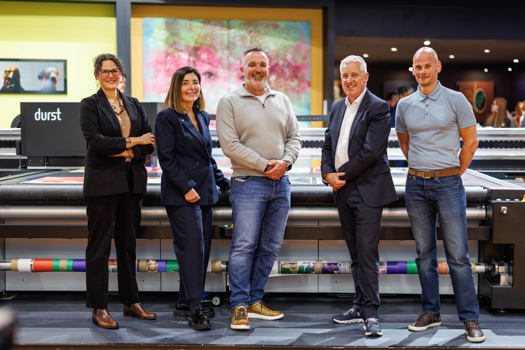Speaking to PrintWeek on day two of Xerox’s inaugural Inkjet-setters Summit conference in Marseille, Xerox Inkjet chief technology officer Paul Morgavi named one “early adopter” as Belgium-based VPrint, while the other has not been named. Phased commercial availability is due to start by the end of the year.
First discussed at Drupa, Xerox’s High Fusion Inks allow for inkjet printing on traditional offset coated stocks, eliminating the need for pre or post treatment and supporting a range of matt, silk and gloss-coated stocks.
Morgavi said: “These are going to be a gamechanger for us. It’s a really strong opportunity to open the market for commercial print with offset coated paper, which is a big demand that we have from the market.
“HFI is opening a new door to applications and new pages – this is very important, it is not replacing the pages we have today but it is a complementary application in order to increase the number of pages we are able to print on using inkjet technology.”
The HFI inks are compatible with Xerox’s Drupa-launched Trivor 2400, which currently uses pigment-based High Density (HD) or High Density 2 (HD2) inks. Owners can retrofit existing Trivor machines with HFI and new buyers will have the choice between HD or HFI. Morgavi gave updates on the new products’ performance, stating that VPrint, which also has a range of offset presses, had quickly adopted use of the inks.
“This is the first application where HFI makes a difference on the market,” he added.
While price has not been disclosed, Xerox graphic communications vice-president Robert Stabler, who updated PrintWeek on the inks’ status at Hunkeler Innovation Days in Switzerland in February, said on day one of the conference that price would be competitive in the offset market.
Elsewhere at the conference, which was in part held at the Aubagne premises of Impika, which was acquired by Xerox in 2013, there were a range of talks and panel discussions into an area where Xerox has accounted for 30% of total installs [continuous feed] in Western Europe in H1 2017, according to Hubert Soviche, vice-president Graphic Communications Solutions.
“Inkjet is a strong area and we need to spend time with you and others to understand the market and its direction for the next five years,” said Soviche.
Speaking alongside Morgavi in a panel discussion, Stabler discussed the challenges of offering inkjet as a strategic complement to offset and cut-sheet.
“The market has moved from the early adopter phase to the mainstream phase. To increase the value of the document is a real challenge that we feel inkjet can solve,” said Stabler.
Mark Hanley, president of US-based digital print consultant I T Strategies, updated the audience on recent developments, stating that the install base of continuous-feed inkjet units worldwide has now reached almost 3,000, with inkjet-printed pages targeted to reach 300 billion by the end of this year, representing 73% year-on-year growth since 2008.
“For a market to go from 0 to 300 billion pages in 10 years is very unusual and significant,” said Hanley.
Also on day one, the first UK-based Trivor 2400 buyer, David Amor of First Move Direct Marketing, spoke on a panel with early inkjet adopters that also included Welsh printer A McClay & Company director Jonathan Thomas, while Xerox vice-president of business development Jonathan Edwards discussed the opportunities for inkjet in catalogue printing.
“Two years ago someone came to me and said Xerox do inkjet and I invested because of the belief in the variability it adds in colour and data,” said Amor.
“For me the economics and solution was so clearly better than what was in the market. I’m surprised by how creative the market is, for me I now don’t want to talk to print buyers, I want to talk to direct marketers.”
There was also an industry experts panel discussion on applications and software with the likes of Hunkeler managing director Stefan Hunkeler and XMPie president Jacob Aizikowitz.
“The transactional market is still growing, direct mail is growing and going back to paper and I believe this will still continue to grow along with books-on-demand,” said Hunkeler.
Earlier this year, Xerox completed the separation of its business into two standalone companies, one handling document technology and the other, Conduent, focusing on Business Process Outsourcing. It was rumoured to be purchasing Kodak’s Prosper and Ultrastream inkjet businesses in March but Kodak chose to retain the businesses.
“I think at the end of the day the management [of Kodak] decided to keep this business as their own because they think they have something to bring to the market,” said Morgavi.










